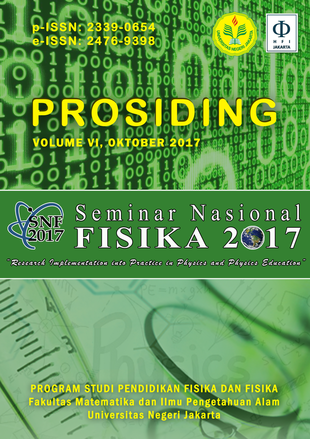KAYU LAPIS BAMBU (BAMBOO PLYWOOD) DARI PEMANFAATAN LIMBAH KERAJINAN BILIK BAMBU
DOI:
https://doi.org/10.21009/03.SNF2017.02.MPS.23Abstract
Abstrak
Bambu (Bambusa vulgaris schrad) merupakan tanaman yang banyak tumbuh di Indonesia. Menggunakan limbah bambu dari kerajinan maka dilakukan penelitian dengan memanfaatkan limbah kerajianan bilik bambu sebagai kayu lapis atau plywood. Tujuan penelitian ini adalah untuk mengetahui karakteristik modulus patah dan modulus elastis kayu lapis bambu. Potongan bambu dengan ukuran panjang10 cm; lebar 3 cm; dan tebal 8 mm dibuat sebagai lapisan dalam pembuatan kayu lapis. Lapisan bambu hingga menjadi triplek dipres serta menggunakan perekat epoxy resin dan hardener. Hasil penelitian menunjukkan bahwa kayu lapis dengan perekat 7% mempunyai modulus patah dan elastisitas tertinggi yaitu sebesar 8654 kg/cm2 dan modulus elastis sebesar 6,94. Semakin tinggi kadar perekat maka semakin tinggi nilai kadar perekat dan semakin tinggi pula nilai modulus patah dan modulus elastisitas.
Kata-kata kunci: Kayu lapis bambu, modulus patah, modulus elastisitas
Abstract
Bamboo (Bambusa vulgaris schrad) is a plant that grows a lot in Indonesia. Using bamboo waste from handicrafts then conducted research by utilizing waste kerajianan bamboo booths as plywood or plywood. The purpose of this research is to know the characteristic Modulus of Rupture and Modulus of Elasticity of bamboo plywood. Pieces of bamboo with length of 10 cm; Width of 3 cm; And 8 mm thick is made as a layer in the manufacture of plywood. Layers of bamboo to be plywood pressed and using epoxy resin and hardener adhesive. The results showed that 7% adhesive plywood had the highest modulus of rupture and elasticity of 8654 kg/cm2 and an elastic modulus of 6.94. The higher the adhesive the higher the adhesive value and higher the modulus of the broken and the modulus of elasticity.
Keywords: Bamboo plywood, Modulus of Rupture, Modulus of Elasticity





